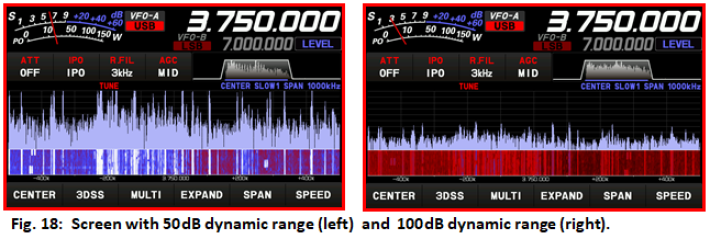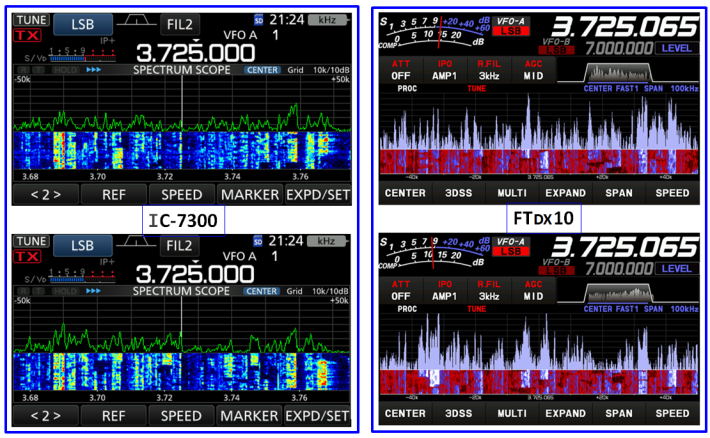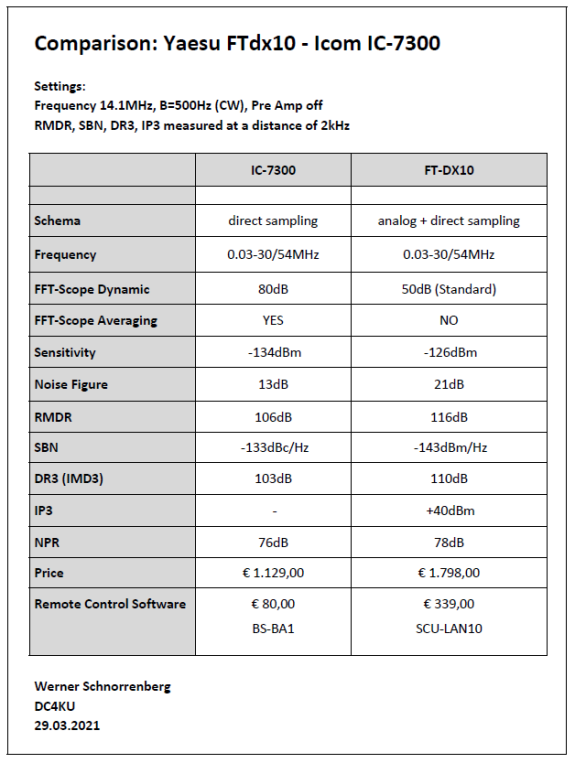Yaesu FTDX10 vs. ICOM IC-7300
The information imediately below was sent to me by Werner, DC4KU.
From: DC4KU
<dc4ku-@-darc.de>
Sent: 10 April 2021 14:37
To: Rick-@-dj0ip.de
Subject: FT-DX10
Summary
The FTDX10 is an excellent HF/6m transceiver and keeps the promised data of the manufacturer. A suitable transceiver for exposed sites and powerful antennas, for newcomers as well as for old established OMs. The combination of an analog mixer plus subsequent digital signal processing (SDR), currently provides the best results. The only drawbacks I could find are the scope dynamic range and the average of the FFT spectrum.
The following comparison between the FTDX10 and IC-7300 shows some of the disadvantages of the FTDX10. Figure 19 tells it all.
Attached (at the bottom of this page) is my comparison sheet FTDX10 vs.
IC-7300, if you like you can distribute it.
In summary of the FTDX10:
- RMDR, SBN, DR3, IP3 are very good.
- Scope averaging: no.
- Sensitivity: bad. You should run the FTDX-10 with [pre-] AMP1=ON.
- Concerning NPR, there is only 2dB Difference between the 7300 and dx10!
Screen, FFT display
The FFT screen works in its basic setting with only 50dB dynamic range. The noise floor therefore appears unusually large and signals with 40dB above noise already exceed the upper limit of the screen and can no longer be estimated. The overview gets a bit lost.
But with a trick, the screen can be set to 100dB: Go to Functions -> Scope -> Display Settings -> 2D Display Sensitivity (Yaesu means the screen dynamic) and switch from Hi to Normal.
Averaging
Neither the sweep rate nor an averaging of the spectrum can be adjusted. If, for example, one wants to average the fidgety spectral lines at a span of 100kHz, so that the noise floor is optically reduced, there is no possibility to do so.
Figure 19 shows the differences. The IC-7300 shows a smoothed spectrum, where especially the noise floor between the signals is strongly attenuated by the averaging. In addition, the peaks of all spectral lines are connected with a continuous green line. The result is a smooth course of the entire spectrum, in which small signals can be easily recognized next to large signals.
However, "averaging" is not possible with the FTDX10. Instead, it displays all spectral lines with a very high sweep rate and the spectrum looks choppy as a result. Because the spectrum cannot be smoothed, the peaks of the noise also appear with large amplitudes, so that small signals are not so easy to recognize. You can get used to the eternal fidgeting of the spectral lines, but it takes time.
The only advantage of a fast-running spectrum (Real Time Spectrum Scope) is that even smallest changes of signals are still recognizable, which would not be possible by averaging. For example, pulsed RF signals can be easily detected even though they may only be visible for a few milliseconds. Military work e.g. with such receivers.
That the receiver of the FTDX10 has no Average functions, I feel as a strong shortcoming. I have brought the issue to Yaesu's attention and they are thinking about a solution to the problem.
Here are a couple more screen shots which I took during a contest:
73, Werner
DC4KU
[Note: Werner’s full test review of the Yaesu FTDX10 will be published in a 2-Part article in “FUNKAMATEUR” magazine, issues May/June 2021.]
Yaesu FTDX10 vs. ICOM IC-7300 Comparison Chart:





























